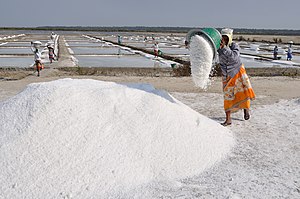
In common usage, salt is a mineral composed primarily of sodium chloride. When used in food, especially at table in ground form in dispensers, it is more formally called table salt. In the form of a natural crystalline mineral, salt is also known as rock salt or halite.
Storage life for salt is indefinite. So long as you keep it dry and do not let it get contaminated, it will never go bad. Over time, iodized salt may turn yellow, but this is harmless and may still be used. Salt it rather hygroscopic and will absorb moisture from the air if not sealed in an air-tight container. If it does absorb moisture and cakes up, it can be dried in the oven and then broken up with no harm done.
All salt, however, is not the same. Salt comes in a number of different varieties, each with its own purpose. Very little of the salt produced in the United States is intended for use in food. The rest of it, about 98%, has other uses. Therefore, it is important to be certain the salt you have is intended for human consumption. Once you are satisfied it is, you should then determine its appropriateness for the tasks to which you might want to set it to.
Sale is a part of the Mormon Basic Four
Iodized salt[edit | edit source]
Trace amounts of the element iodine (about 150 micrograms of iodine per day for adults) are necessary to prevent problems with thyroid function such as goiter (enlargement of the thyroid gland). Dietary iodine is readily available in seafood and sea vegetables ("seaweed", marine algae, commonly used in Japanese cuisine), but is rare in other dietary sources. Therefore trace amounts of iodine are commonly added to dietary salt.
As with ordinary salt, iodized salt should be kept in airtight containers when stored for long-term.
See also[edit | edit source]
- Curing
- Canning salt
- Halite
- Kosher salt
- Rock salt
- Sea salt
- Solar salt
- Salt substitutes
- Table salt
- Harvesting salt